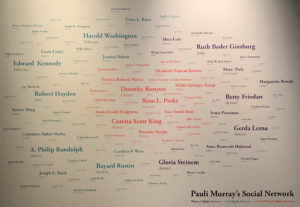
Reverend Dr. Pauli Murray’s exhibit at the NC Museum of History
by Adalia
Back when the Pauli Murray exhibit opened at the North Carolina Museum of History, I went to watch the documentary, My Name is Pauli Murray, at the Museum’s theater. Before watching, I walked through the exhibit, which is open until November 27. I had never heard of Murray before and what I had read during my quick Google search didn’t encapsulate their personality much. However, the exhibit and documentary taught me so much more about the wonderful Pauli Murray!
The title, “Imp, Crusader, Dude, Priest,” and opening of the exhibit, already began to put Pauli Murray into perspective, especially with the pictures, printed on enormous canvases. Each showed a different part of Murray, portraying the intersectionality of them. But what really struck home all these intersections of who Murray was, was a graphic with different pieces of them displayed. In the middle, it reads “human rights are indivisible,” and each piece gives information on different pieces of Pauli.
In the top right corner, it reads “between black and white,” noting how diverse Murray’s family tree is with ancestors of Black, White and Indigenous descent. It has a quote of Murray’s, which reads, “in a world of black-white opposition, I had no place…being neither very dark nor very fair, I was a nobody without identity.” Even from a young age, the prejudice against different parts of them affected who they were.
The top right corner is “between male and female,” something which Murray struggled with particularly because of the lack of fluidity and acceptance in the time they were alive. It mentions how Murray chose the name “Pauli” “to reflect their ‘he/she personality’” and explains how Murray sought our hormone treatment, believing that something was wrong with their body.
The next circle depicts the difference “between working class and middle class.” Murray was an extremely successful academic, with advanced degrees in English Literature, Law and Divinity, yet, because of their race and sexual orientation, their options were limited. Because of the struggles they faced finding equal economic opportunity, Murray became a workers’ rights activist.
The last circle reads, “between homosexual and heterosexual,” quoting Murray asking, “Why is it that my greatest attractions have been toward extremely feminine and heterosexual women?? Why do I desire monogamous married life as a completion?” Murray never publicly identified as LGBTQIA+, however they expressed affection for Irene Barlow as a partner and spiritual mate, who shares a headstone with Pauli.
Already, the exhibit showed pieces of who Murray was. Each additional picture, plack or graphic helped add to who they were and the amazing things they accomplished.
Ingredients for a Movement: 1 Person, 1 Typewriter
One really important part of Murray was writing. They wrote several books, in addition to countless articles, essays, sermons and speeches. Writing was one of their forms of activism, which they point out in a 1965 quote: “One person plus one typewriter constitutes a movement.” In addition to the activism aspect of writing, poetry was a way for Murray to understand themself, from their race to gender to class.
Their most well-known book Proud Shoes: The Story of an American Family follows the story of Murray’s maternal grandparents, who were from Durham, North Carolina, and their story of surviving slavery and miscegenation from before the Civil War till the Reconstruction Era. It was written in 1956 and is still studied today to learn about African American genealogy in the United States.
Pauli Murray Through the People Who Knew Them
One part of the exhibit, which I found most intriguing, was a graphic of Murray’s social network, which listed a number of well-known activists, including Ruth Bader Ginsburg and Rosa Parks. This showed just how diverse Murray’s friends were and can be a synonym for how many people were affected by their actions.
Along with the “Pauli Murray’s Social Network” poster, the museum had Murray’s address book, which listed over 500 friends, allies, acquaintances and more, whom they had interacted with during their life.
A project, called “Finding Jane Crow,” was based on the extensive list of names and stories within Murray’s address book. This name came from a term Murray had coined: “Jane Crow,” meaning prejudice against women, which they felt could be compared to Jim Crow laws.
Honoring Pauli Murray
One of the last things to come across in the exhibit is a beautiful copy of a graffiti painting of Murray, with a quote of theirs at the bottom from their book, Proud Shoes. It says, “It had taken me almost a lifetime to discover that true emancipation lies in the acceptance of the whole past, in deriving strength from all my roots, in facing up to the degradation as well as the dignity of my ancestors.” This mural, along with several others in Durham, North Carolina, were painted by the community in honor of Murray’s work for equality for all people: people of color, women, the working class and many more. Without the work of this amazing human being, who would be arrested for sitting in the whites-only section of the bus fifteen years before Rosa Parks, several legal actions and countless other moments in history might not have happened.
There is so much more to explore about Pauli Murray, even in this exhibit alone, which really only skims the surface of who they were. This exhibit is free and open until November 27, 2022 at the North Carolina Museum of History in Raleigh, and I highly recommend taking a trip to learn more if you are in the area! If you can’t go to the exhibit, I recommend watching My Name is Pauli Murray on Amazon Prime (even if documentaries aren’t really your thing) because it has so much information about all of the different things in our world touched by Pauli Murray.



